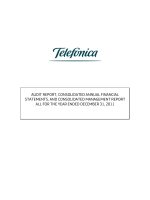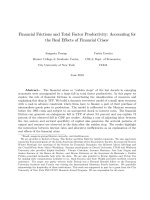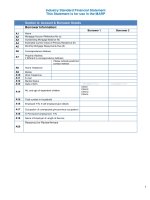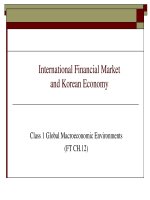International Financial Market and Korean Economy asset approach in the short run
Bạn đang xem bản rút gọn của tài liệu. Xem và tải ngay bản đầy đủ của tài liệu tại đây (1.25 MB, 61 trang )
International Financial market and Korean Economy
Prepared by Seok-Kyun HUR
Asset Approach in the Short Run
Introduction
• Substantial deviations from purchasing power parity (PPP)
occur in the short run: the same basket of goods generally does
not cost the same everywhere at all times.
• These short-run failures of the monetary approach prompted
economists to develop an alternative theory to explain
exchange rates in the short run: the asset approach to exchange
rates, the subject of today’s lecure.
• The asset approach is based on the idea that currencies are
assets.
• The price of the asset in this case is the spot exchange rate, the
price of one unit of foreign exchange.
Exchange Rates and Interest Rates in the Short Run:
UIP and FX Market Equilibrium
Risky Arbitrage
The uncovered interest parity (UIP) equation is the fundamental
equation of the asset approach to exchange rates.
(15-1)
FIGURE 15-1
Building Block: Uncovered Interest Parity—The Fundamental Equation of the Asset Approach
In this model, the nominal interest rate and expected future exchange rate are treated as known
exogenous variables (in green).
The model uses these variables to predict the unknown endogenous variable (in red), the current
spot exchange rate.
TABLE 15-1
Interest Rates, Exchange Rates, Expected Returns, and FX Market Equilibrium: A Numerical
Example
The foreign exchange (FX) market is in equilibrium when the domestic and foreign returns are equal. In
this example, the dollar interest rate is 5%, the euro interest rate is 3%, and the expected future exchange
rate (one year ahead) is = 1.224 $/€. The equilibrium is highlighted in bold type, where both returns are 5%
in annual dollar terms. Figure 12-2 plots the domestic and foreign returns (columns 1 and 6) against the
spot exchange rate (column 3). Figures are rounded in this table.
Equilibrium in the FX Market: An Example
FIGURE 15-2
FX Market Equilibrium: A
Numerical Example
The returns calculated in Table
15-1 are plotted in this figure.
The dollar interest rate is 5%,
the euro interest rate is 3%,
and the expected future
exchange rate is 1.224 $/€.
The foreign exchange market
is in equilibrium at point 1,
where the domestic returns DR
and expected foreign returns
FR are equal at 5% and the
spot exchange rate is 1.20 $/€.
Changes in Domestic and Foreign Returns and FX Market
Equilibrium
To gain greater familiarity with the model, let’s see how the FX
market example shown in Figure 15-2 responds to three separate
shocks:
■ A higher domestic interest rate, i$ = 7%
■ A lower foreign interest rate, i€ = 1%
■ A lower expected future exchange rate, Ee$/€ = 1.20 $/€
Changes in Domestic and Foreign Returns and FX Market Equilibrium
A Change in the Domestic Interest Rate
FIGURE 15-3 (1 of 3)
(a) A Change in the Home
Interest Rate
A rise in the dollar interest
rate from 5% to 7% increases
domestic returns, shifting the
DR curve up from DR1 to DR2.
At the initial equilibrium
exchange rate of 1.20 $/€ on
DR2, domestic returns are
above foreign returns at point
4.
Dollar deposits are more
attractive and the dollar
appreciates from 1.20 $/€ to
1.177 $/€. The new
equilibrium is at point 5.
Changes in Domestic and Foreign Returns and FX Market Equilibrium
A Change in the Foreign Interest Rate
FIGURE 15-3 (2 of 3)
(b) A Change in the Foreign
Interest Rate
A fall in the euro interest rate
from 3% to 1% lowers foreign
expected dollar returns,
shifting the FR curve down
from FR1 to FR2.
At the initial equilibrium
exchange rate of 1.20 $/€ on
FR2, foreign returns are below
domestic returns at point 6.
Dollar deposits are more
attractive and the dollar
appreciates from 1.20 $/€ to
1.177 $/€. The new
equilibrium is at point 7.
Changes in Domestic and Foreign Returns and FX Market Equilibrium
A Change in the Expected Future Exchange Rate
FIGURE 15-3 (3 of 3)
(c) A Change in the Expected
Future Exchange Rate
A fall in the expected future
exchange rate from 1.224 to 1.20
lowers foreign expected dollar
returns, shifting the FR curve
down from FR1 to FR2.
At the initial equilibrium
exchange rate of 1.20 $/€ on
FR2, foreign returns are below
domestic returns at point 6.
Dollar deposits are more
attractive and the dollar
appreciates from 1.20 $/€ to
1.177 $/€. The new equilibrium
is at point 7.
Money Market Equilibrium in the Short Run: How
Nominal Interest Rates Are Determined
The Assumptions
In this chapter, we make short-run assumptions that are quite
different from the long-run assumptions of the last chapter:
■ In the short run, the price level is sticky;
it is a known
—
predetermined variable, fixed at P = P (the bar indicates a fixed
value).
■ In the short run, the nominal interest rate i is fully flexible and
adjusts to bring the money market to equilibrium.
• The assumption of sticky prices, also called nominal rigidity, is
common to the study of macroeconomics in the short run.
Money Market Equilibrium in the Short Run: How
Nominal Interest Rates Are Determined
The Model
The expressions for money market equilibrium in the two
countries are as follows:
𝑀𝑀𝑈𝑈𝑈𝑈
= 𝐿𝐿(𝑖𝑖𝑈𝑈𝑈𝑈 ) × 𝑌𝑌𝑈𝑈𝑈𝑈
𝑃𝑃�𝑈𝑈𝑈𝑈
𝑀𝑀𝐸𝐸𝐸𝐸𝐸𝐸
= 𝐿𝐿(𝑖𝑖𝐸𝐸𝐸𝐸𝐸𝐸 ) × 𝑌𝑌𝐸𝐸𝐸𝐸𝐸𝐸
𝑃𝑃�𝐸𝐸𝐸𝐸𝐸𝐸
(15-2)
(15-3)
Money Market Equilibrium in the Short Run: Graphical Solution
FIGURE 15-4 (1 of 2)
Equilibrium in the Home Money
Market
The supply and demand for real
money balances determine the
nominal interest rate.
The money supply curve (MS) is
— because the
vertical at M1US/P
US
quantity of money supplied does
not depend on the interest rate.
The money demand curve (MD)
is downward-sloping because an
increase in the interest rate
raises the cost of holding money,
thus lowering the quantity
demanded.
Money Market Equilibrium in the Short Run: Graphical Solution
FIGURE 15-4 (2 of 2)
Equilibrium in the Home Money
Market
The money market is in
equilibrium when the nominal
interest rate i1$ is such that real
money demand equals real
money supply (point 1).
At points 2 and 3, demand does
not equal supply and the interest
rate will adjust until the money
market returns to equilibrium.
Another Building Block: Short-Run
Money Market Equilibrium
FIGURE 15-5
Building Block: The Money Market Equilibrium in the Short Run
In these models, the money supply and real income are known exogenous variables (in green
boxes).
The models use these variables to predict the unknown endogenous variables (in red boxes), the
nominal interest rates in each country.
Changes in Money Supply and the Nominal Interest Rate
FIGURE 15-6 (1 of 2)
Home Money Market with Changes in Money Supply and Money Demand
—
In panel (a), with a fixed price level P1US, an increase in nominal money supply from M1US to
—
—
M2US causes an increase in real money supply from M1US/P1US to M2US/P1US.
The nominal interest rate falls from i1$ to i2$ to restore equilibrium at point 2.
Changes in Money Supply and the Nominal Interest Rate
FIGURE 15-6 (2 of 2)
Home Money Market with Changes in Money Supply and Money Demand (continued)
—
In panel (b), with a fixed price level P1US, an increase in real income from Y1US to Y2US causes
real money demand to increase from MD1 to MD2.
To restore equilibrium at point 2, the interest rate rises from i1$ to i2$.
APPLICATION
Can Central Banks Always Control the Interest Rate? A Lesson from the Crisis of
2008–2009
• In the United States, the Federal Reserve sets as its policy rate
the interest rate that it charges banks for overnight loans.
• In normal times, changes in this cost of short-term funds for
the banks are usually passed through into the market rates the
banks charge to borrowers as well as on interbank loans
between the banks themselves.
• This process is one of the most basic elements in the so-called
transmission mechanism through which the effects of
monetary policy are eventually felt in the real economy.
APPLICATION
Can Central Banks Always Control the Interest Rate? A Lesson from the Crisis of
2008–2009
• In the recent crisis, although the Fed brought its policy rate all
the way down from 5.25% to 0% in 2007 and 2008, there was
no similar decrease in market rates.
• A second problem arose once policy rates hit the zero lower
bound (ZLB). At that point, the central banks’ capacity to
lower interest rate further was exhausted. However, many
central banks wanted to keep applying downward pressure to
market rates to calm financial markets. The Fed’s response
was a policy of quantitative easing.
APPLICATION
Can Central Banks Always Control the Interest Rate? A Lesson from the Crisis of
2008–2009
The Fed engaged in a number of extraordinary policy actions to
push more money out more quickly:
1. It expanded the range of credit securities it would accept as
collateral to include lower-grade, private-sector bonds.
2. It expanded the range of securities that it would buy outright
to include private-sector credit instruments such as
commercial papers and mortgage-backed securities.
3. It expanded the range of counterparties from which it would
buy securities to include some nonbank institutions such as
primary dealers and money market funds.
APPLICATION
Can Central Banks Always Control the Interest Rate? A Lesson from the Crisis of
2008–2009
A broken transmission: the Fed’s extraordinary interventions did
little to change private credit market interest rates in 2008–
2009.■
The Monetary Model: The Short Run versus the Long Run
Consider the following example: the Home central bank that
previously kept the money supply constant suddenly switches to
an expansionary policy. In the following year, it allows the money
supply to grow at a rate of 5%.
■ If such expansions are expected to be a permanent policy in the
long run, the predictions of the long-run monetary approach and
Fisher effect are clear. The Home interest rate rises in the long
run.
■ If this expansion is expected to be temporary, then, all else
equal, the immediate effect is an excess supply of real money
balances. The home interest rate will then fall in the short run.
The Asset Approach to Exchange Rates: Graphical Solution
FIGURE 15-7 (1 of 2)
Home Money Market with Changes in Money Supply and Money Demand
The figure summarizes the equilibria in the two asset markets in one diagram.
In panel (a), in the home (U.S.) money market, the home nominal interest rate i1$ is determined by
the levels of real money supply MS and demand MD with equilibrium at point 1.
The Asset Approach to Exchange Rates: Graphical Solution
FIGURE 15-7 (2 of 2)
Home Money Market with Changes in Money Supply and Money Demand
In panel (b), in the dollar-euro FX market, the spot exchange rate E1$/€ is determined by foreign and
domestic expected returns, with equilibrium at point 1′. Arbitrage forces the domestic and foreign
returns in the FX market to be equal, a result that depends on capital mobility.
Capital Mobility Is Crucial
Our assumption that DR equals FR depends on capital mobility. If
capital controls are imposed, there is no arbitrage and no reason
why DR has to equal FR.
Putting the Model to Work
With this graphical apparatus in place, it is relatively
straightforward to solve for the exchange rate given all the known
(exogenous) variables we have specified previously.









